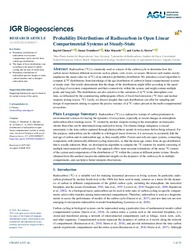Probability Distributions of Radiocarbon in Open Linear Compartmental Systems at Steady‐State
DOI: https://doi.org/10.1029/2021JG006673
Persistent URL: http://resolver.sub.uni-goettingen.de/purl?gldocs-11858/9992
Persistent URL: http://resolver.sub.uni-goettingen.de/purl?gldocs-11858/9992
Supplement: https://doi.org/10.5281/zenodo.6373329
Chanca, Ingrid; Trumbore, Susan; Macario, Kita; Sierra, Carlos A., 2022: Probability Distributions of Radiocarbon in Open Linear Compartmental Systems at Steady‐State. In: Journal of Geophysical Research: Biogeosciences, Band 127, 3, DOI: 10.1029/2021JG006673.
 |
Dokument öffnen: |
Radiocarbon (14C) is commonly used as a tracer of the carbon cycle to determine how fast carbon moves between different reservoirs such as plants, soils, rivers, or oceans. However such studies mostly emphasize the mean value (as Δ14C) of an unknown probability distribution. We introduce a novel algorithm to compute Δ14C distributions from knowledge of the age distribution of carbon in linear compartmental systems at steady‐state. Our results demonstrate that the shape of the distributions might differ according to the speed of cycling of ecosystem compartments and their connectivity within the system, and might contain multiple peaks and long tails. The distributions are also sensitive to the variations of Δ14C in the atmosphere over time, as influenced by the counteracting anthropogenic effects of fossil‐fuel emissions (14C‐free) and nuclear weapons testing (excess 14C). Lastly, we discuss insights that such distributions can offer for sampling and design of experiments aiming to capture the precise variance of Δ14C values present in the multi‐compartmental ecosystems. Plain Language Summary:
Radiocarbon (14C) is a radioactive isotope of carbon prominent in environmental sciences for tracing the dynamics of ecosystems, especially as recent changes in atmospheric radiocarbon allow tracking excess 14C created by nuclear weapons testing in the atmosphere on timescales shorter than what can be determined using radioactive decay. For climate change mitigation, a crucial uncertainty is the time carbon captured through photosynthesis spends in ecosystems before being released. For this purpose, radiocarbon can be valuable as a biological tracer; however, it is necessary to accurately link the real age of carbon and its radiocarbon age, as they usually differ. Forests and soils are open systems, connecting components with intrinsically different cycling timescales, so that the mean age comes from an age distribution that is usually unknown. Here, we developed an algorithm to compute the 14C contents for models consisting of multiple interconnected carbon pools. Our approach offers more accurate estimations of the mean 14C content of the system and computations of the distribution of 14C within the system at different points in time. Results obtained from this method can provide additional insights on the dynamics of the carbon cycle in multiple compartments, and can help to better interpret observations. Key Points:
Probability distributions of radiocarbon in ecosystem compartments can be derived from carbon age distributions.
The shape of these distributions vary according to the speed of carbon cycling and the year of observation.
Probability distributions of radiocarbon provide insights to study carbon dynamics and to interpret radiocarbon data.
Statistik:
ZugriffsstatistikSammlung:
This is an open access article under the terms of the Creative Commons Attribution License, which permits use, distribution and reproduction in any medium, provided the original work is properly cited.

